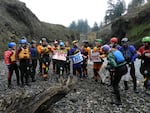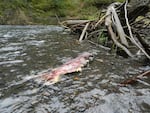
Steelhead falls, a rapid located in a narrow canyon between PacifiCorp's Condit Dam and powerhouse. Dam removal has restored the flow in this section of the White Salmon River.
Thomas O'Keefe
HUSUM, Wash. -- Last week, power company PacifiCorp quietly announced it had finished removing the Condit Dam in southwest Washington. It’s the second largest dam removal ever in the United States, and it’s revealed a stretch of the White Salmon River that was lost for 100 years.
On Sunday Todd Collins, a guide with Wet Planet Rafting, addressed a crowd of 30 people in wetsuits and splash jackets. They’d traveled here from across the Northwest to paddle through the old site of the Condit Dam.
“It’s probably the most beautiful section of the white salmon river. And I’m talking from Trout Lake all the way down. It’s pretty stunning,” Collins told the crowd.
PacifiCorp blasted a hole in the dam last October. It’s taken a year to pull out the rest of the concrete out and clear debris.
Collins warned the paddlers to watch out for the trees that are still working their way down the river. And to avoid taking an accidental swim.
“I think swims would be pretty scary, because you don't really know what's in there, and there's just logs that are in places and formations that don't make any sense.”
The mood was euphoric. Kayakers pushed off from shore in plastic boats colored like Skittles candies. A handful of local kayakers ran the river when it officially opened a week earlier, and Collins said other people may have been paddling illegally before then. But this was the first descent for many people who fought to remove the dam.
A yellow raft carried three fish biologists who have come to observe the river’s transformation, including Margaret Neuman, director of the Mid-Columbia Fisheries Enhancement Group.
"I’m super excited to see the lower river and to see the habitat that’s opened up and what fish might be here already,” she said.
The Condit was 125 feet tall and it didn’t have fish ladders -- one of the primary reasons it was targeted for removal.
Neuman said last year, as the deconstruction began, steelhead trout found the hole in the dam and began swimming through it and appearing upriver.
“This 20 pound fish could do something a human could never do. We could never swim up a waterfall. We could never swim through a hole in a dam,” she said.
Swift water carries the raft and the biologists downstream. They reached the edge of what was once Northwestern Lake, a shallow man-made reservoir behind the dam.
Jeanette Burkhardt, with the Yakama Nation fisheries team, pointed to the shore.
“What we're starting to see is kind of a bathtub ring where the water level used to be.”
The flowing river has cut its way down through the bottom of the old lakebed, sweeping gravel and sediment downstream. PacifiCorp estimates the river has moved at least two thirds of the gravel and fine sediment that built up behind the dam over 100 years.
Rope swings that once hurled children into the lake dangled 80 feet above the water. A home on the lakeshore was collapsing into the river and a sunken boat hungs overhead.
A small pile of rocks at a narrow spot was the only sign of where Condit Dam stood.
With whoops and cheers, the expedition pulled over on a gravel bar on the west bank and stopped for pictures and Champagne. But the real treat for the kayakers was up ahead.
The river bounced down Steelhead Falls, a Class-IV rapid and then raced into a narrow green canyon. You could almost touch the rock walls with your fingertips.
Jeanette Burkhardt said this roaring whitewater used to be just a trickle. PacifiCorp diverted the water here to a powerhouse downstream where it generated electricity.
“So it looks so much different now that all of the water that used to be in the river is back in this stretch. And it’s gorgeous.”
As the river widened, the biologists pointed out long gravel beds. Brady Allen, a biologist with the U.S. Geological Survey, said all this gravel was trapped behind the dam.
“There was very little gravel because the dam held it all up," he said. "Big floods scoured the rest of it down below and it couldn’t be rejuvenated. The river is probably about four or five feet higher than it was when the dam was holding it all back.”
Removing the dam and releasing the gravel has created miles of new salmon habitat. Females have scoured the newly deposited gravel with their tails and laid their eggs. Hundreds of red chinook salmon streak across the river like comets.
“There’s so many fish in here in this stretch. There’s just tons of them spawning and holding and moving around. Every few seconds you see another one,” Allen said.
The wind carried an ammonia smell, from the dying fish. Eagles, herons, and ducks have all taken note. Burkhardt said she’s seen signs of other animals returning, too.
“If you keep an eye out in the fine sediment we saw a bunch of bear tracks the other day. They are obviously smelling what we smell and coming down here to see what they can snack on,” Burkhardt said.
As the White Salmon flowed into the Columbia River, the rafts and kayaks pulled to shore. Pat Arnold, Chair of Friends of the White Salmon River, stepped onto dry land and shivered.
“I'm cold. But I feel great. It's just exciting to be part of such a big event in natural history.”
Arnold said even with the dam gone, the future of the White Salmon River is uncertain. Klickitat County has proposed new development along the river. She worries that could hurt water quality. But today, she was just happy to see the river flowing freely:
“There’s a lot of work to be done. This is the beginning. It’s not the end at all."
The Wet Planet guides say the newly opened section of the White Salmon is changing every month. Don’t try it unless you’re a confident Class-IV paddler.






